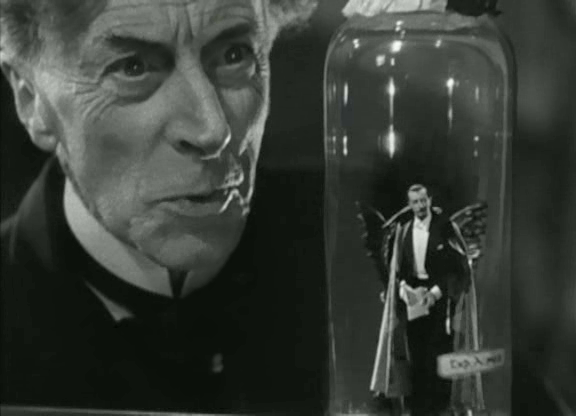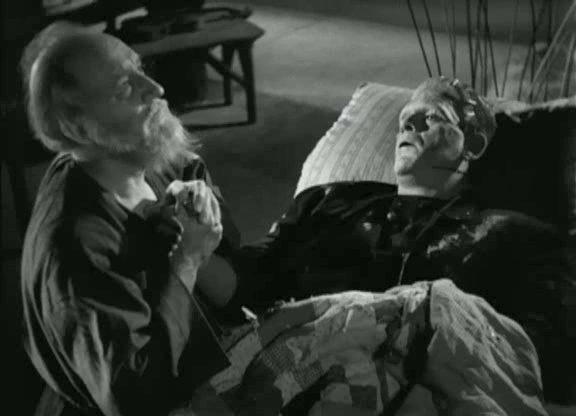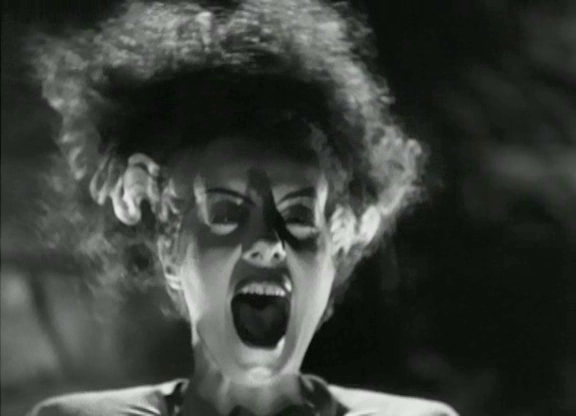In celebration of the Season of Terror, Deadshirt Editor Emeritus and horror film neophyte Dylan Roth asked Comics Editor Kayleigh Hearn to introduce him to one of her favorites. She selected the 1935 classic Bride of Frankenstein. How did it pan out?
Kayleigh: Widely hailed as a horror classic and one of the best sequels of all time, Bride of Frankenstein is a film unlike any other. James Whale’s sequel to his earlier Frankenstein (1931) continues the story of the undead monster, as his maker Dr. Henry Frankenstein is forced by the cadaverous Dr. Pretorius to make a mate for the lonely creature. Macabre, perverse, and at times deliciously funny, Bride of Frankenstein casts a long shadow, influencing countless horror films (Bride of Re-Animator), comedies (Young Frankenstein), and even Oingo Boingo songs. I don’t remember when I first saw it—probably late one foggy night on TCM—but it’s an evergreen Halloween favorite. Dylan, what did you think watching it for the first time?
Dylan: This was indeed my first time seeing this movie from beginning to end, but as I was watching, I was surprised to discover that I’d actually seen a fair number of chunks of Bride of Frankenstein and mistaken it for the 1931 original. The sequence with the Creature and the blind hermit—which is so famously parodied by Mel Brooks, Gene Hackman, and Peter Boyle in Young Frankenstein—I could have sworn was in the first movie. It’s actually startling how much classic Frankenstein mythology and imagery comes directly from the sequel, and I think that speaks to just how well this film holds up.
Kayleigh: So much of Bride has entered the public consciousness! Think of every cartoon or playground monster that ever grunted, “Fire…bad!” That’s Boris Karloff. (Who, surprisingly enough, was against humanizing the monster by letting it talk.) Do you prefer Frankenstein’s Monster as a hulking brute, or the sad, lonely misfit we see here?
Dylan: I really appreciated Bride’s interpretation of the Monster—it feels like a solid middle ground between the brainless colossus of the first film and more sadsack intellectual versions that emulate the original novel more closely (see: Van Helsing). I may also be biased in favor of this version because it’s so clearly the inspiration for the one presented in Young Frankenstein, as well as The Munsters, probably. Even without knowing where it all came from, this immediately stood out as being the “real” Frankenstein to me. And given that Bride of Frankenstein is a favorite of yours, I gather you feel similarly.
Kayleigh: For me, Bride of Frankenstein is a perfect film. “Iconic” is the most overused word in film criticism, but every scene in its tight 74 minutes works, which is an achievement because it’s such a strange film. The early Universal horror pictures, like Dracula, are often stilted and theatrical, betraying their status as still-experimental talkies. Bride is a fully confident work, dark and shrouded with horror, but at the same time brimming with broad, even campy comedy. (The monster smokes!) Does it juggle these shifting tones well? What do you make of characters like Una O’Connor as the perpetually shrieking Minnie, or waspish Dr. Pretorius?
Dylan: I love Minnie. She reminds me of a comic relief character in a Shakespeare tragedy. Bride of Frankenstein is just enough like a stage play that I 100% forgive the huge, over-emotive acting. I don’t know how it played in 1935, but given that eighty years have diluted a lot of the horror of the production anyway, I found the intentional comedy actually improves the scares that have fallen flat due to age. The audience is given permission to laugh a number of times in the film, so when you laugh when you’re not supposed to, it feels less mean and more fun. I can’t imagine that you were ever supposed to find DOCTOR PRETOOOORIUS more menacing than charming. He’s just so much fun. Bride of Frankenstein’s primary concern seems to be showing the audience a really good time, and in that respect it reminded me a lot of contemporary blockbusters.
I personally didn’t find Bride of Frankenstein all that chilling, but I don’t feel as if it’s ever supposed to terrify you. Do you get any scares out of this movie?
Kayleigh: Bride of Frankenstein isn’t a movie that jumps out to scare you, but I think it’s effective at building a sense of mortal, creeping dread. There’s all that beautiful black-and-white cinematography and set design–burning windmills, yawning crypts, and crumbling laboratories. It’s also a movie about loneliness, something I think most of us are afraid of, undead abominations or not. The monster’s search for a companion in a world that hates and wants to destroy him is deeply sad. “We belong dead” is the most chilling line in a horror movie I can think of.
Dylan: The final twist—that not even the person ostensibly created just to keep him company can see him as anything but a monster—is so cruel, in part because it’s also predictable. The only comfort the monster can ever find is the blind hermit, and that’s taken from him. There’s a lot of scholarship out there about coded homosexuality in Bride of Frankenstein, mostly about the relationship between Drs. Frankenstein and Pretorius, but there’s also the subplot where the discarded Creature finally finds some peace and belonging with another man, and then the outside world immediately intrudes to tell these two happy people that their friendship is wrong and dangerous, and pulls them from each other. The hermit’s cry of “Why?” as the townsfolk drag him from his home was the most affecting moment in the film for me.
There’s a lot of subtext to dig into in Bride, and then there’s also the occasional weirdness that is seemingly about nothing at all. Dr. Pretorius has apparently grown a quartet of tiny people in little jars, a stunning feat of mad science that is immediately forgotten about. Apart from being a memorable visual effect (that holds up very well after eighty years), I couldn’t tell you what, if anything, Pretorius’s menagerie is meant to symbolize, it’s just a fun little moment.
Kayleigh: Pretorius’s menagerie is definitely the biggest “wait, what the fuck?” moment of the movie. Like, oh yeah, he can create tiny, living people, here’s a ballerina in a jar. Dr. Frankenstein likens it to black magic, and that sudden splash of the supernatural is the only time the movie’s universe seems at risk of exploding. And yet it’s just weird enough that it still works.
Oh yes, one of my favorite things to talk about in this movie, the queer subtext! James Whale, who was gay, gives the film a sly, campy edge that still feels wonderfully transgressive today. Dr. Pretorius interrupts Frankenstein’s honeymoon like a scorned ex-flame, and of course making the monster’s mate is a symbolic act of creating life outside the bonds of heterosexual intercourse. It gives more gravity to the idea that this is a film about outsiders. And what about that creation? What about…THE BRIDE?
Dylan: THE BRIDE HERSELF, an instantly (forgive me) ICONIC figure, appears in the film for a scant three minutes or so and still makes an indelible mark on American cinema. I enjoy the way that even the film’s opening credits attempt to obscure the identity of the Bride. Early in the film, there’s the looming metatextual threat that Henry’s own bride Elizabeth may be transformed into the titular character, then there’s the multitude of townsfolk who die offscreen but whose demise is specifically mentioned, and there’s that final body that’s retrieved from the mausoleum. Apart from Elizabeth, we don’t see any of their faces. And yet, when the bandages are unwrapped, the Bride still has a familiar face—why, it’s Mary Wollstonecraft Shelley (Elsa Lanchester), from the prologue! In case you forgot, this whole story is being spun by a fictionalized version of the author herself, and while it’s a fun little visual twist, the idea that she has cast herself as her creation’s would-be mate is also worth digging into.
Kayleigh: I love Elsa Lanchester! She only bookends the film, but she’s so unforgettable that she feels like a much large presence. She’s so much fun as Mary Shelley—beautiful, of course, but with a sharp cleverness underneath the demure exterior she puts on for the benefit of the condescending Lord Byron and Percy Shelley. Mary is going to fuck up their dreams tonight, and she knows it. Elsa Lanchester’s dual role is thematically brilliant, and reveals a lot about how this version of Mary Shelley sees herself. It challenges the rules of conventional femininity in a way that’s still as relevant today as it was in 1935—how could a seemingly gentle little woman write something as violent and disturbing as Frankenstein? But Mary contains multitudes, and the monster and the monster’s maker are one and the same..
But yes, for all that, the titular Bride of Frankenstein has a surprisingly small role on screen. Does she live up to the hype? Does the film?
Dylan: Bride of Frankenstein absolutely holds up for me. It’s a very memorable, very deliberate film that earns its reputation as the original “superior sequel.” With Universal rebooting its classic Monsters line in a shared cinematic universe, a new remake is probably inevitable, but more than the 1931 Frankenstein, this one would be tough to beat.
Screencaps by Misfit Robot Daydream.






